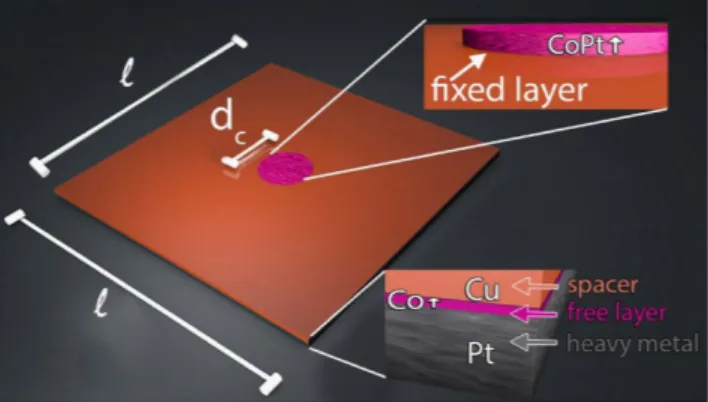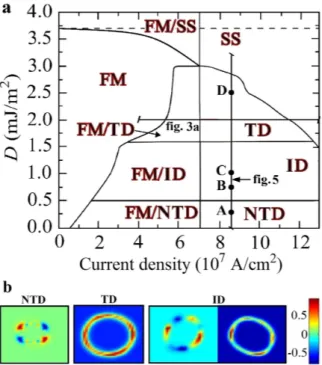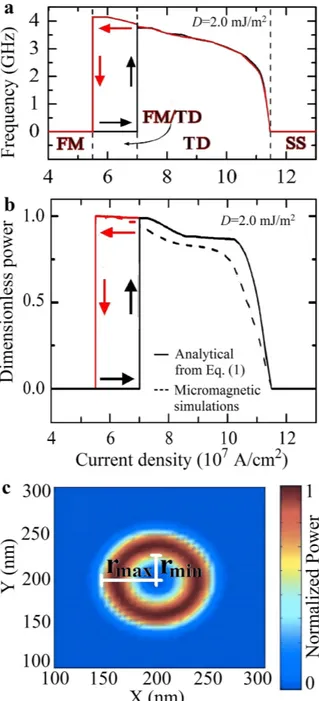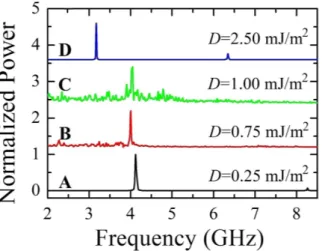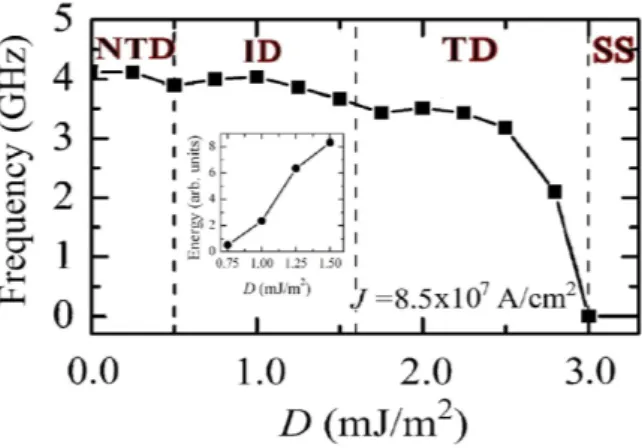instanton droplets driven by
spin-transfer torque in materials with
perpendicular magnetic anisotropy
and Dzyaloshinskii–Moriya
Interaction
Mario Carpentieri1, Riccardo Tomasello2, Roberto Zivieri1,3 & Giovanni Finocchio4
The interfacial Dzyaloshinskii–Moriya Interaction can modify the topology of droplets excited by a localized spin-polarized current. Here, we show that, in addition to the stationary droplet excitations with skyrmion number either one (topological) or zero (non-topological), there exists, for a fixed current, an excited mode with a non-stationary time behavior. We call this mode “instanton droplet”, which is characterized by time domain transitions of the skyrmion number. These transitions are coupled to an emission of incoherent spin-waves that can be observed in the frequency domain as a source of noise. Our results are interesting from a fundamental point of view to study spin-wave emissions due to a topological transition in current-driven systems, and could open the route for experiments based on magnetoresistance effect for the design of a further generation of nanoscale microwave oscillators.
Solitons are self-localized wave packets that can be observed in media characterized by non-linear and dispersive constitutive laws and can be also classified on the basis of their topology, i.e. the skyr-mion number1–5. The study of magnetic solitons6,7 has been reinforced by the experimental evidence
that spin-transfer torque (STT)8 can nucleate both static and dynamic solitons from a uniform state or
manipulate strongly non-uniform magnetic configurations. In particular, static solitons can be achieved in either in-plane (vortices, antivortices, and domain walls) or out-of-plane devices (bubbles, skyrmi-ons, and domain walls) and they can behave like particles, e.g. vortex9 and skyrmion10–13 can rotate
around a nanocontact in point contact geometries (oscillators), skyrmions and domain walls can be shifted in a track (racetrack memory)14–17. On the other hand, dynamical solitons that are unstable in
dissipative magnetic materials, can be sustained by the STT and used as source of microwave emissions (self-oscillations) in nanoscale oscillators18–23. In the recent literature, much attention has been given to
the investigation of dynamical properties of topologically protected particles in materials with perpendic-ular magnetic anisotropy, i.e. skyrmions24, while only few works have been devoted to the identification
1Department of Electrical and Information Engineering, Politecnico di Bari, via E. Orabona 4, I-70125 Bari, Italy. 2Department of Computer Science, Modelling, Electronics and System Science, University of Calabria, via P. Bucci 41C, I-87036, Rende (CS), Italy. 3Department of Physics and Earth Sciences and CNISM Unit of Ferrara, University of Ferrara, Ferrara, via Saragat 1, I-44122, Ferrara, Italy. 4Department of Electronic Engineering, Industrial Chemistry and Engineering, University of Messina, c.da di Dio, I-98166, Messina, Italy. Correspondence and requests for Received: 13 July 2015
accepted: 12 October 2015 Published: 09 November 2015
and study of topological modes25. In detail, the excitation of a topological mode was predicted by Zhou
et al.25 and used to explain recent experimental observations in CoNi26.
In this paper, we describe how the transition from non-topological droplet (NTD) to topological drop-let (TD) or dynamical skyrmion occurs as a function of the i-DMI27–29. The adjectives “non-topological”
and “topological” are used to identify a mode with a skyrmion number zero (S = 0) and one (S = 1), respectively, since the skyrmion number characterizes the topological structure20. Our key result is that
the mode transition from NTD to TD is achieved through an intermediate i-DMI region, where the time-domain traces of the excitation exhibit non-stationary changes from NTD to TD and vice versa. We have called this new mode “instanton droplet” (ID), which can be seen as a combination of the TD and NTD, characterized by continuous changes of the skyrmion number. This excitation can be experi-mentally observed by means of microwave emissions data.
Results
Phase diagram description. Figure 1 shows a sketch of the studied device, consisting of a spin-valve of Pt(5 nm)/Co(0.6 nm)/Cu (4 nm)/CoPt(4 nm). The ultrathin Co layer acts as free layer (FL) (square cross section of 400 × 400 nm2 and thickness of 0.6 nm), while the CoPt acts as fixed layer or polarizer
and it is shaped as a circular point contact (diameter dc = 70 nm) in order to locally inject the current
into the FL. Both FL and polarizer have an out-of-plane magnetic state at zero bias field. A Cartesian coordinate system, with the x- and y-axes oriented along the in-plane directions of the device and the z-axis along its thickness, has been introduced.
Figure 2a summarizes the phase diagram of the magnetization as a function of the current density (swept back and forth) and the i-DMI parameter D. For the sake of simplicity, in the following, the current density J < 0 (the current flows from the FL to the fixed layer) is given in modulus. Five different states can be identified, two static states: uniform state along the z-direction (FM) and static skyrmion (SS), and three dynamical states, NTD20,21, TD and ID. The i-DMI regions described above are separated
by straight horizontal lines, as obtained with a D resolution of 0.05 mJ/m2, whereas the dotted line for
D = 3.7 mJ/m2 marks the i-DMI value above which the skyrmion, once nucleated, is stable without
cur-rent. In some current regions, the FM state is overlapped with the three dynamical states, since all the modes deal with a sub-critical Hopf bifurcation30 (finite power at the threshold, current density
hyster-esis, the mode is switched off at a current density smaller than the excitation value, and the oscillation axis is different from the equilibrium configuration in the FM state). Starting from the FM state, the modes are excited at J = 7.0 × 107 A/cm2 (D < 3.0 mJ/m2) independently of the i-DMI, while the switch-off
current density depends on the i-DMI. This is due to the dependence of the i-DMI field (see equation (4) in Methods) on the spatial derivative of the magnetization that does not influence the excitation current in the uniform state. The SS state is achieved for 1.6 < D ≤ 3.0 mJ/m2 from the TD state with a
reversible transition, while a static skyrmion, once excited, is stable with no current for D ≥ 3.7 mJ/m2.
From the theory developed in29, the critical i-DMI parameter that stabilizes the skyrmion state is given
by Dc=4 Akπeff = .4 4 mJ/m2, where keff =ku − 12 0µMs2. As expected and already well discussed in29,
the analytical value is larger than the micromagnetic one because the Dc expression has been derived
within a 1D model.
We have also performed a systematic study of the stability phase diagram as a function of different physical parameters, namely the perpendicular anisotropy constant ku, the exchange stiffness constant A
and the Gilbert damping αG. We found that, in order to achieve magnetization dynamics at zero external
and the diameter dc of the nanocontact are illustrated, together with the dimensions l × l of the square cross
magnetic field, a high perpendicular anisotropy (ku > 0.95 MJ/m3) is needed, whose values have been
already measured in similar devices31.
Discussion
Topological and non-topological droplet. The NTD mode is excited for D ≤ 0.5 mJ/m2 (see
sup-plementary material MOVIE 1 for the NTD mode at D = 0.0 mJ/m2 and J = 8.5 × 107 A/cm2). The NTD
dynamics concerns a 360° in-plane rotation of the domain wall spins18,20,21. Unlike previous studies, where
the NTD is characterized by two or four regions19,20 of opposite topological density, here the NTD exhibits a
more complex behavior as can be also seen from a snapshot of the topological density in Fig. 2b and from the supplementary material MOVIE 2 (D = 0.0 mJ/m2 and J = 8.5 × 107 A/cm2). Close to D = 0.25 mJ/m2,
the NTD is characterized by a small shift of the droplet core together with the domain wall spins rota-tions (see supplementary material MOVIE 3 for the magnetization dynamics at D = 0.25 mJ/m2 and
J = 8.5 × 107 A/cm2). The origin of the different topological density of the NTD will be discussed ahead
in the last subsection.
The TD is excited for 1.6 < D ≤ 3.0 mJ/m2. It exhibits a core breathing dynamics that is synchronized
with a 360° in phase rotation (space and time) of the domain wall spins (see supplementary material MOVIE 4 for D = 2.5 mJ/m2 and J = 8.5 × 107 A/cm2), which can be seen as a continual change from
Néel (radial outward and inward) to Bloch (counter clockwise and clockwise) skyrmion magnetic texture (S = − 1, see a snapshot of the topological density in Fig. 2b and the supplementary material MOVIE 5 for D = 2.5 mJ/m2 and J = 8.5 × 107 A/cm2).
Figures 3a,b show the frequency-current and the output power vs current for D = 2.0 mJ/m2 as
com-puted from simulations, respectively. The oscillation frequency of the TD (at values smaller than the ferromagnetic resonance (FMR) frequency, about 37 GHz) decreases with increasing current19. The
oscil-lation power computed from the z-component of the magnetization (perpendicular polarizer) shows a finite value at the excitation current when the initial state is the FM, as expected for a sub-critical Hopf bifurcation, whereas it tends to zero as soon as the SS state is approached. These results show that the TD state can be seen as a reversible linear mode of the SS justifying the name of dynamical skyrmion already used in literature.
Looking at the spatial distribution of the oscillating spins of the TD modes (see Fig. 3c) for the two-dimensional profile of the TD for D = 2.5 mJ/m2 and J = 8.5 × 107 A/cm2 as computed with the
micromagnetic spectral mapping technique32,33, it is easy to demonstrate that the dimensionless output
Figure 2. Magnetization phase diagram and topological density. (a) Stability phase diagram of the
magnetization ground-state as a function of the modulus of the current density and of D at zero external magnetic field. Letters (A–D) are linked to Fig. 4. The meaning of the symbols in the phase diagram are as follows. FM: ferromagnetic; SS: static skyrmion; TD: topological droplet; NTD: non-topological droplet, ID: instanton droplet. (b) Spatial distribution of the topological density (a color scale is represented, red + 1, blue − 1) for the three dynamical states NTD, TD, and ID at i-DMI values of 0.00, 2.50, and 1.25 mJ/m2,
power p, due to a variation in the Giant Magnetoresistance (GMR) signal, is related to the breathing mode as: = − ≤ − > ( ) p r r r r r r r r 1 1 1 c c c min2 max2 max min2 2 max
Figure 3. Oscillation frequency and power vs. current density. (a) Frequency-current density hysteresis
loop at D = 2.0 mJ/m2: the black (red) arrows indicate the path where the initial state is FM (SS). (b) Output
power as a function of current density for D = 2.0 mJ/m2. The solid line refers to the analytical computation
from equation (1), while the dotted line is determined by micromagnetic calculations. The black (red) arrows indicate the path where the initial state is FM (SS). (c) Two dimensional spatial profile of the TD for D = 2.5 mJ/m2.
being rmin and rmax the minimum and maximum radius of the TD during the breathing and rc the radius
of the point contact (see Fig. 3c). The dimensionless output power calculated according to equation (1) shows a very good agreement with the one computed by means of micromagnetic simulations (Fig. 3b).
The TD mode described in this study, already observed in25, is different from the ones seen in17 where
the breathing mode is just a transient due to the application of the spin current, in34 where the breathing
mode is a resonant state of a static skyrmion excited by a microwave field, and in26 where no
synchro-nization between the core breathing and domain wall spins precessions is detected. Other topological modes have been already found in in-plane materials such as vortex-antivortex pairs35, (S = ± 1) and
vortex-quadrupole (S = ± 2)36.
Instanton droplet. In general, in 2D systems the topological states are represented by local minima in the free energy landscape separated by a finite energy barrier. This energy barrier is proportional to the exchange contribution in a texture where the spins are not locally parallel but resemble through a hedgehog-like spin configuration with a singular point in the middle. This magnetic structure can be called “instanton”, which in our framework is a time-dependent magnetization configuration connecting different topological states37,38. In the i-DMI region 0.5 < D ≤ 1.6 mJ/m2, time domain changes in the
topology (skyrmion number) of the topological mode are found, in particular a configuration linkable to NTD or to TD can be observed.
The first definition of instanton was classical and referred to localized finite-action solutions of the classical Euclidean field equations with finite Euclidean action37. Recently, an instanton dynamics
has been introduced to study the quantum dynamics of vortices in magnetic disks starting from the generalized Thiele’s equation39. In analogy, we have defined an instanton as a time-dependent
config-uration connecting different topological states. In other words, in our framework the term “instanton” has been introduced with the aim to extend this important notion to low-dimensional semi-classically described magnetic systems, thus achieving the classical correspondence of the pseudoparticles theo-retically found in40. This has been obtained by solving micromagnetically the LLGS equation of motion
for low-dimensional magnetic systems. Specifically, we identify with “instanton droplet” only the i-DMI region where the dynamics is characterized by a variation in time of the topological charge (skyrmion number) passing from TD (S = − 1) to NTD (S = 0) and vice versa.
The continual changes in the droplet topology generate incoherent emission of spin waves41,42, being
the topological transition non periodic. The magnetization dynamics for J = 8.5 × 107 A/cm2 at three
dif-ferent values of D (0.75, 1.00, and 1.25 mJ/m2) can be seen in the supplementary material MOVIES 6–8.
To highlight the main characteristics of the dynamical states of the phase diagram, the Fourier spectra for different values of i-DMI (D = 0.25, 0.75, 1.00, and 2.50 mJ/m2) are shown in Fig. 4. The NTD and
TD are characterized by a single mode (the Fourier spectra exhibit a main frequency peak at 4.12 GHz for D = 0.25 mJ/m2 and at 3.17 GHz for D = 2.5 mJ/m2, respectively). In the ID region, the time-domain
non-stationary topological transitions give rise to the excitations of incoherent spin waves leading to noisy Fourier spectra (see the spectra for D = 0.75 and D = 1.00 mJ/m2). From an experimental point of
view, it is possible to detect the ID region by performing microwave emission measurements.
Figure 5 summarizes the oscillation frequency linked to the mode with larger power as a function of the i-DMI for a fixed current density of 8.5 × 107 A/cm2, as indicated in Fig. 2a. The transition from a
dynamical region to the other one is similar to the topological transitions from skyrmion to a uniform ferromagnetic state or vice versa as described in43. In particular, the topological changes characterizing
the instanton droplet can be seen as finite-time singularities43 which are driven by the spin-polarized
Figure 4. Fourier spectra. Frequency spectra as a function of the i-DMI, when J = 8.5 × 107 A/cm2. Capital
current. The inset of Fig. 5 shows the energy related to the continual change of the topology as a func-tion of D, within a time window of 42 ns. The energy increases with D because more stable topological droplets are achieved.
Control of the topological density of NTDs. Finally, we have studied the mode excitation for different contact diameters. Figure 6 shows the Fourier spectra of the magnetization dynamics when J = 8.5 × 107 A/cm2 and zero i-DMI for three different values of d
c. As expected, by injecting the same
current density, the frequency of the domain wall rotation increases while decreasing the nanocontact diameter due to energy balance between the current input and the Gilbert damping. Moreover, for the smallest dc, the spatial distribution of the topological density is composed of four different regions (see
supplementary material MOVIE 9 for dc = 40 nm), whereas for the larger diameters a more complicated
topological density distribution is obtained, including several alternated regions with positive and nega-tive topological density (see supplementary material MOVIE 10 for dc = 100 nm). Our results show that
the topological density of the NTD can be controlled by the size of the nanocontact dc.
Micromagnetic simulations show qualitatively the same phase diagrams for contact size larger than 50 nm. In particular, for D = 2.50 mJ/m2, the TD state is excited in the range (3.0 < J ≤ 6.5) × 107 A/cm2
and (7.0 < J ≤ 9.0) × 107 A/cm2 for d
c = 100 nm and dc = 70 nm, respectively. When dc = 40 nm, the TD
mode is not excited, even when the spin-polarized current is increased. This is due to the fact that the small size of the nanocontact hampers the breathing mode of the droplet. However, at reduced contact diameter sizes dc < 50 nm, to stabilize a TD, an external out of plane field is necessary (not shown).
In summary, micromagnetic results point out that the additional degree of freedom of the i-DMI energy together with a spin-polarized current can drive transitions from either static to dynamical or Figure 5. Oscillation frequency vs. i-DMI. Oscillation frequency as a function of D for J = 8.5 × 10 A/cm. The different states are indicated. The inset shows the energy related to ID transitions as a function of D for J = 8.5 × 107 A/cm2.
Figure 6. Effect of the contact size on the NTD. Frequency spectra as a function of the contact diameter
dc, when J = 8.5 × 107 A/cm2 and zero i-DMI, together with the spatial distribution of the topological density
τ = − × +α τ × + × ( × ) ( ) d d d d B m m h m m m m p 2 G eff
where m and heff are the normalized magnetization and the effective field of the ferromagnet. τ = γ0Ms
t is the dimensionless time. γ0 is the gyromagnetic ratio and αG is the Gilbert damping. The third term
in equation (2) is the dimensionless Slonczewski spin-transfer torque, where p = P/Ms represents the
dimensionless magnetization of the fixed layer, and =B gγµBM edJ P m p( , )
s
0 2 , where g is the Landè factor, e and μB are the electric charge and the Bohr magneton, respectively. J is the current density and d is the
thickness of the FL, while P(m, p) is a polarization function depending on the relative orientation of the magnetizations. The effective field includes the standard magnetic field contributions and the i-DMI field45. A complete description of the numerical framework can be found in46–48.
The coupled Pt heavy metal adds the i-DMI as an additional degree of freedom in the energy land-scape of the FL. The i-DMI energy density and the effective field expressions are45:
εi−DMI =D m[ z∇ ⋅m− ( ⋅ ∇)m mz] ( )3 µ δε δ µ = − = − (∇ ) − ∇ ( ) − − · ˆ h M D M z m m m 1 2 [ ] 4 i S i z DMI 0 DMI 0 S
respectively, where mz is the z-component of the normalized magnetization, Ms is the saturation
mag-netization of the FL, δ stands for functional (variational) derivative and the ultrathin film hypothesis
(
∂∂mz =0)
is considered, while the boundary condition is ddnm = ( × ) ×1ξ ˆz n m, where ξ = A D2 (being A
the exchange constant) is a characteristic length in the presence of DMI29.
The micromagnetic parameters, typical of Co, are saturation magnetization Ms = 900 kA/m,
perpen-dicular uniaxial anisotropy constant ku = 1.10 MJ/m3, exchange stiffness constant A = 20 pJ/m, and
mag-netic damping αG = 0.1. All the simulations have been performed without any bias field and for a range
of i-DMI parameter 0 < D < 4.0 mJ/m2 and of current density 0 < J < 13 × 107 A/cm2.
The topological density n has been computed directly from the magnetization configuration as
(
)
= ⋅ ∂ × ∂
n m ym xm, while the skyrmion number S is given by S= π
∫
n x y dxdy( , )1
4 . Here, the
droplet is considered topological or non-topological if |S| ≈ 1 or S ≈ 0, respectively, for all t, while the instanton droplet is characterized by a time dependent skyrmion number |S(t)|, changing from 0 to 1.
References
1. Remoissenet, M. Waves Called Solitons: Concepts and Experiments, Springer, Berlin/Heidelberg, (1994). 2. Khaykovich, L. et al. Formation of a Matter-Wave Bright Soliton, Science 296, 1290 (2002).
3. Grelu, P. & Akhmediev, N. Dissipative solitons for mode-locked lasers, Nat. Photonics 6, 84 (2012). 4. Herr, T. et al. Temporal solitons in optical microresonators, Nat. Photonics 8, 145 (2014).
5. Komarov, A., Komarov, K., Niang, A. & Sanchez, F. Nature of soliton interaction in fiber lasers with continuous external optical injection, Phys. Rev. A 89, 013833 (2014).
6. Kosevich, A. M., Ivanov, B. A. & Kovalev, A. S. Magnetic Solitons, Physics Reports 194, 117–238 (1990).
7. Moutafis, C., Komineas, S. & Bland, J. A. C. Dynamics and switching processes for magnetic bubbles in nanoelements, Phys. Rev. B 79, 224429 (2009).
8. Slonczewski, J. C. Current-driven excitation of magnetic multilayers. J. Magn. Magn. Mater. 159, L1 (1996). 9. Petit-Watelot, S. et al. Commensurability and chaos in magnetic vortex oscillations, Nat. Phys. 8, 682–687 (2012). 10. Zhang, S. et al. Current-induced magnetic skyrmions oscillator, New Journal of Physics 17, 023061 (2015).
11. Nagaosa, N. & Tokura, Y. Topological properties and dynamics of magnetic skyrmions, Nat. Nanotech. 8, 899–911 (2013). 12. Romming, N. et al. Writing and deleting single magnetic skyrmions, Science 341, 636–639 (2013).
13. Heinze, S. et al. Spontaneous atomic-scale magnetic skyrmion lattice in two dimensions, Nat. Phys. 7, 713–718 (2011). 14. Emori, S., Bauer, U., Ahn, S.-M., Martinez, E. & Beach, G. S. D. Current-driven dynamics of chiral ferromagnetic domain walls,
Nat. Mater. 12, 611–616 (2013).
15. Fert, A., Cros, V. & Sampiao, J. Skyrmions on the track, Nat. Nanotech. 8, 152 (2013).
16. Sampaio, J., Cros, V., Rohart, S., Thiaville, A. & Fert, A. Nucleation, stability and current-induced motion of isolated magnetic skyrmions in nanostructures, Nat. Nanotech. 8, 839 (2013).
29. Rohart, S. & Thiaville, A. Skyrmion confinement in ultrathin film nanostructures in the presence of Dzyaloshinskii-Moriya interaction, Phys. Rev. B 88, 184422 (2013).
30. Finocchio, G. et al. Hysteretic spin-wave excitation in spin-torque oscillators as a function of the in-plane field angle: a micromagnetic description, J. Appl. Phys. 110, 123913 (2011).
31. Miron, I. M. et al. Perpendicular switching of a single ferromagnetic layer induced by in-plane current injection. Nature 476, 189–193 (2011).
32. Carpentieri, M., Finocchio, G., Azzerboni, B. & Torres, L. Spin-transfer-torque resonant switching and injection locking in the presence of a weak external microwave field for spin valves with perpendicular materials, Phys. Rev. B 82, 094434 (2010). 33. Finocchio, G., Carpentieri, M., Giordano, A. & Azzerboni, B. Non-Adlerian phase slip and nonstationary synchronization of
spin-torque oscillators to a microwave source, Phys. Rev. B 86, 014438 (2012).
34. Kim, J. -V. et al. Breathing modes of confined skyrmions in ultrathin magnetic dots, Phys. Rev. B 90, 064410 (2014).
35. Komineas, S. Frequency generation by a magnetic vortex-antivortex dipole in spin-polarized current. Europhys. Lett. 98, 57002 (2012).
36. Giordano, A. et al. Micromagnetic Study of Spin-Transfer-Driven Vortex Dipole and Vortex Quadrupole Dynamics IEEE Trans.
Magn. 50, 11 (2014).
37. Rajaraman, R. Solitons and Instantons, North-Holland, Amsterdam, (1982).
38. Ivanov, B. A., Khymyn, R. S. & Kolezhuk, A. K. Pairing of Solitons in Two-Dimensional S= 1 Magnets, Phys. Rev. Lett. 100, 047203 (2008).
39. Zarzuela, R. et al. Quantum dynamics of vortices in mesoscopic magnetic disks, Phys. Rev. B 87, 144420 (2013). 40. Belavin, A. A. et al. Pseudoparticle solutions of the Yang-Mills equations, Phys. Lett. 59B, 85 (1975).
41. Mochizuki, M. Spin-Wave Modes and Their Intense Excitation Effects in Skyrmion Crystals, Phys. Rev. Lett. 108, 017601 (2012). 42. Schütte, C. & Garst, M. Magnon-skyrmion scattering in chiral magnets, Phys. Rev. B 90, 094423 (2014).
43. Verga, A. D. Skyrmion to ferromagnetic state transition: A description of the topological change as a finite-time singularity in the skyrmion dynamics, Phys. Rev. B 90, 174428 (2014).
44. Zeng, Z. et al. Ultralow-current-density and bias-field-free spin-transfer nano-oscillator, Sci. Rep. 3, 1426 (2013).
45. Tomasello, R., Carpentieri, M. & Finocchio, G. Influence of the Dzyaloshinskii-Moriya interaction on the spin-torque diode effect, J. Appl. Phys. 115, 17C730 (2014).
46. Lopez-Diaz, L. et al. Micromagnetic simulations using Graphics Processing Units J. Phys. D Appl. Phys. 45, 323001 (2012). 47. Moriyama, T. et al. Phase locking and frequency doubling in spin-transfer-torque oscillators with two coupled free layers, Phys.
Rev. B 86, 060411(R) (2012).
48. S. L. GoParallel, https://www.goparallel.net/index.php/gp-software, (2012) Date of access: 01/07/2015.
Acknowledgements
This work was supported by the MIUR-PRIN 2010–11 Project 2010ECA8P3 “DyNanoMag” and the bilateral agreement Italy-Turkey project (Code B52I14002910005) “Nanoscale magnetic devices based on the coupling of Spintronics and Spinorbitronics”. The authors thank Prof. Achim Rosch for the useful discussions.
Author Contributions
M.C. and R.T. performed micromagnetic simulations. R.Z. analyzed the data and wrote the paper. G.F., M.C. and R.T. conceived and designed the numerical experiment, analyzed the data and wrote the paper. All authors contributed to the general discussion and comment on the manuscript.
Additional Information
Supplementary information accompanies this paper at http://www.nature.com/srep Competing financial interests: The authors declare no competing financial interests. How to cite this article: Carpentieri, M. et al. Topological, non-topological and instanton
droplets driven by spin-transfer torque in materials with perpendicular magnetic anisotropy and Dzyaloshinskii-Moriya Interaction. Sci. Rep. 5, 16184; doi: 10.1038/srep16184 (2015).
This work is licensed under a Creative Commons Attribution 4.0 International License. The images or other third party material in this article are included in the article’s Creative Com-mons license, unless indicated otherwise in the credit line; if the material is not included under the Creative Commons license, users will need to obtain permission from the license holder to reproduce the material. To view a copy of this license, visit http://creativecommons.org/licenses/by/4.0/
